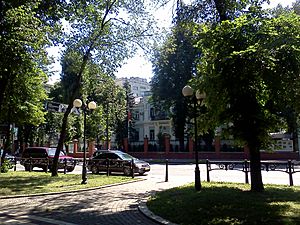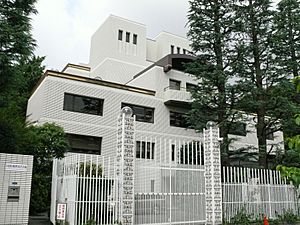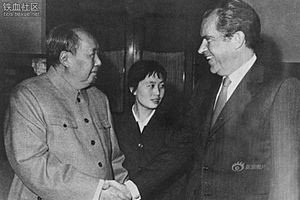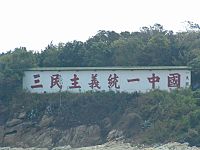One China facts for kids
Quick facts for kids One China |
|||||||||||
|---|---|---|---|---|---|---|---|---|---|---|---|
| Traditional Chinese | 一個中國 | ||||||||||
| Simplified Chinese | 一个中国 | ||||||||||
|
|||||||||||
| One China principle | |||||||||||
|---|---|---|---|---|---|---|---|---|---|---|---|
| Traditional Chinese | 一個中國原則 | ||||||||||
| Simplified Chinese | 一个中国原则 | ||||||||||
|
|||||||||||
| One China with respective interpretations | |||||||
|---|---|---|---|---|---|---|---|
| Traditional Chinese | 一個中國各自表述 | ||||||
| Simplified Chinese | 一个中国各自表述 | ||||||
|
|||||||
| One China policy | |||||||||||
|---|---|---|---|---|---|---|---|---|---|---|---|
| Traditional Chinese | 一個中國政策 | ||||||||||
| Simplified Chinese | 一个中国政策 | ||||||||||
|
|||||||||||
The term One China is a big idea in international politics. It refers to the belief that there is only one China in the world. However, different groups have different ideas about what "China" means and who should govern it.
There are three main ways people use the term "One China":
- The One China principle is what the People's Republic of China (PRC) believes. They say there's only one country called China, and the PRC is its only legal government. They also believe that Taiwan is a part of China. This idea is against the thought that there are two separate states (the PRC and the Republic of China, or ROC). It also opposes the idea that China and Taiwan are two different countries.
- One China with respective interpretations is an idea from Taiwan's Kuomintang (KMT) party. They say that both the PRC and ROC agreed there's one "China," but they disagree on whether the PRC or ROC represents it. The PRC has not accepted this idea. Another major party in Taiwan, the Democratic Progressive Party (DPP), does not agree with any "1992 Consensus" or the idea that both sides of the Taiwan Strait are "one China."
- The One China policy is what the United States uses. It's a bit unclear on purpose. The U.S. knows that both sides of the Taiwan Strait believe there's only one China and that Taiwan is part of it. The U.S. doesn't argue with this idea. It also wants to see the Taiwan question solved peacefully. The U.S. has official relations with the PRC as the only legal government of China. At the same time, it keeps unofficial ties with Taiwan, but does not say China owns Taiwan. Many other countries also have their own "One China" policies.
After the Chinese Communist Party (CCP) won the Chinese Civil War against the Kuomintang (KMT), the KMT government moved to Taiwan. The CCP then started the PRC in mainland China. For a while, both governments claimed to be the true government of all China. Many countries first recognized the ROC, but in the 1970s, most countries, including the U.S. in 1979, started recognizing the PRC instead. The U.S. "One China policy" first appeared in a 1972 agreement with the PRC.
In the 1990s, Taiwan became a democracy. This changed how people in Taiwan viewed the "One China" idea. Parties like the KMT often support "One China with respective interpretations." Parties like the Democratic Progressive Party (DPP) do not accept the "One China" idea at all. Meanwhile, the PRC still strongly believes in its "One China principle."
Contents
How the "One China" Idea Started
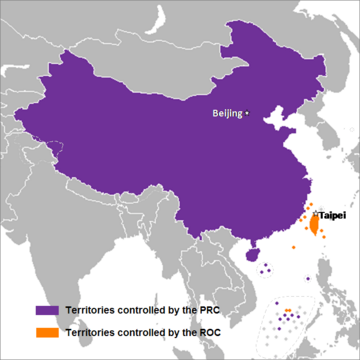
Taiwan's history is complex. European countries like the Dutch and Spanish had colonies there in the 1600s. Many Chinese people from Fujian Province also moved to Taiwan. Later, a Ming dynasty loyalist took control, and then the Qing dynasty of China took over Taiwan in 1683. Taiwan became a separate province of China in 1887.
However, in 1895, after a war, China gave Taiwan to Japan. Taiwan was under Japanese control until the end of World War II in 1945. After the war, the Republic of China (ROC) government, led by the Kuomintang (KMT), took control of Taiwan.
In 1949, the KMT lost the Chinese Civil War to the Chinese Communist Party (CCP) on mainland China. The KMT government then moved to Taiwan. Both the ROC in Taiwan and the new PRC on the mainland claimed to be the only true government of all China.
In 1971, the United Nations General Assembly Resolution 2758 decided that the PRC would take China's seat in the United Nations, replacing the ROC. In the 1990s, the ROC in Taiwan became a free and democratic state. This led to more discussions about Taiwan's future, including ideas for Taiwan independence.
Different Views in Taiwan
In Taiwan, the two main political parties, the Kuomintang (KMT) and the Democratic Progressive Party (DPP), have different ideas about "One China."
The Kuomintang (KMT) believes in a "One China principle." They say that under the ROC Constitution, the ROC has power over most of China, including both mainland China and Taiwan. After the Chinese Civil War in 1949, the KMT government in Taiwan still claimed to be the true government of all China. Later, the ROC Constitution was changed to mainly apply to the Taiwan Area. The KMT now supports a modified "One China" idea called the "1992 Consensus." This means both sides agree there's one China, but they disagree on which government represents it.
The Democratic Progressive Party (DPP) does not agree with the "One China principle." Their official view is that Taiwan is already an independent country. They believe Taiwan's power comes from its citizens. They see Taiwan as an independent nation under the name Republic of China, so they don't think a formal declaration of independence is needed. People who support the Taiwan independence movement also oppose the "One China principle."
How the "One China" Idea Has Changed
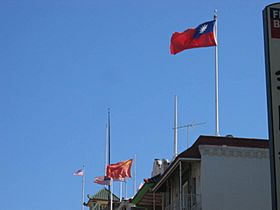
During the Cold War, many countries in the West supported the ROC, while countries in the East supported the PRC. Each side believed they were the only true government of China. The PRC still held this view strongly until the early 2000s. Then, the PRC started to be a bit more flexible to encourage Chinese unification.
The PRC's updated view was shown in the Anti-Secession Law of 2005. This law says there is one China and it cannot be divided. It doesn't clearly say that the PRC is that one China. Beijing has shifted its definition of "One China" to include the '1992 Consensus'. This means both sides of the Taiwan Strait recognize there is only one China, but they can disagree on what "China" means.
One way to think about "One China" is that there is only one geographical area of China. This area was split between two Chinese governments during the Chinese Civil War. People in mainland China who want to unite China believe that "one China" should eventually come together under one government.
PRC's View on "One China"
In practice, official sources in the PRC never call Taiwan's government the "ROC government." They usually call it the "Taiwan authorities." Also, the PRC does not accept or stamp Republic of China passports. People from Taiwan visiting mainland China must use a special permit.
In 1950, China's leader Zhou Enlai said that Taiwan is part of China. He said this was a historical fact and was supported by agreements like the Cairo Declaration and the Potsdam Declaration.
ROC's View on "One China"
Before the 1990s, Chiang Kai-shek, a former leader of the ROC, believed there was one China that should be united under the ROC government.
The ROC's official statement on "One China" from 1992 said:
- Both sides of the Strait have different ideas about "one China." For Beijing, it means the PRC. For Taipei (Taiwan), it means the ROC, which was founded in 1912. The ROC now only governs Taiwan and some nearby islands.
- China has been temporarily divided since 1949, with each side governed by a different group.
- The ROC government wants to unite China peacefully and democratically.
However, opinions in Taiwan have changed since 1992. The group that made that statement was stopped in 2006. The KMT generally accepts the "One China principle." For example, former ROC President Ma Ying-jeou said in 2006 that "One China is the Republic of China." But the DPP does not accept this idea and sees Taiwan as a separate country. Former DPP president Tsai Ing-wen rejected the 1992 Consensus in 2019.
The ROC does not recognize or stamp PRC passports. People from mainland China visiting Taiwan must use a special permit issued by Taiwan.
How Other Countries See "One China"
For any country to have official diplomatic relations with the People's Republic of China, they usually must agree not to formally recognize the ROC. This often forces countries to choose between Beijing and Taipei. Sometimes, the PRC offers money to smaller countries to recognize it instead of the ROC.
Many countries try to find a way to have official ties with the PRC while keeping unofficial ties with the ROC. They might say they "acknowledge," "understand," or "take note of" the PRC's "One China principle," but they don't always say they "recognize" it. This allows them to be a bit unclear on purpose.
When Taiwan takes part in international events like the Olympics or the World Trade Organization, it often uses names like "Chinese Taipei" or "Separate Customs Territory of Taiwan, Penghu, Kinmen, and Matsu." This is because "Taiwan" might suggest it's a separate country, and "Republic of China" might suggest there are two Chinas. Both of these go against the "One China principle."
United States Policy
The United States' "One China policy" was first stated in 1972. It says that the U.S. "acknowledges that Chinese on either side of the Taiwan Strait maintain there is but one China and that Taiwan is a part of China." The U.S. "does not challenge that position." The U.S. has not clearly said whether it believes Taiwan is independent or not. Instead, it says it understands the PRC's claims over Taiwan.
In 1979, the U.S. officially switched its diplomatic recognition from the ROC to the PRC. However, the U.S. Congress quickly passed the Taiwan Relations Act. This law defines relations with the ROC and requires the U.S. to provide Taiwan with weapons for its self-defense. But it doesn't promise that the U.S. will fight if Taiwan is invaded.
In 1982, the U.S. also made "Six Assurances" to Taiwan. One of these was that the U.S. would not formally recognize China's power over Taiwan. The U.S. policy remains somewhat unclear.
In 1998, President Bill Clinton stated "three nos" for U.S. policy:
- Not recognizing two Chinas.
- Not supporting Taiwan's independence.
- Not supporting Taiwan joining international groups that require being a sovereign country.
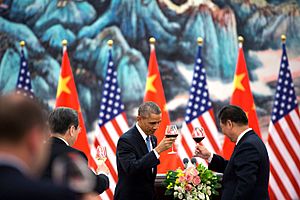
The U.S. position can be summarized:
- The U.S. has not clearly stated Taiwan's status in its agreements with the PRC.
- The U.S. "acknowledged" the "One China" view of both sides.
- U.S. policy has not recognized the PRC's power over Taiwan.
- U.S. policy has not recognized Taiwan as a sovereign country.
- U.S. policy sees Taiwan's status as not yet settled.
In 2016, then-President-elect Donald Trump spoke with Taiwan's President. Later, he said the U.S. was not necessarily bound by its "one China" policy. However, in 2017, President Trump agreed to honor the "one China" policy after talking with China's leader Xi Jinping.
In 2022, U.S. President Joe Biden said the U.S. would step in militarily if China invaded Taiwan. He later clarified that his comments didn't change the U.S. policy of being unclear on purpose.
Japanese Position
In 1972, Japan and China agreed that Japan "fully understands and respects" China's view that "Taiwan is an inseparable part of the territory of the People's Republic of China." Japan has recognized the PRC as the "sole legal Government of China" since 1975. However, Japan has remained unclear about the PRC's claim of power over Taiwan.
Russian Position
In 1949, the Soviet Union recognized the People's Republic of China as the only lawful government of China. Russia continues to support the "One China policy," believing that Taiwan is "an inseparable part of China." They also oppose any forms of independence for Taiwan. This was confirmed in a 2001 agreement between China and Russia.
Philippine Policy
The Philippines also follows a "One China Policy." However, it still has economic and cultural ties with the Republic of China (Taiwan), even though it officially recognizes the People's Republic of China. This policy means the Philippines cannot make political or military agreements with Taiwan.
Relations Across the Taiwan Strait
The PRC government requires that any talks with groups from Taiwan must accept the "One China principle." The PRC does not accept ideas like "two Chinas" or "one China, one Taiwan." It has said that efforts to divide China could lead to military action.
However, the PRC has also said it is flexible about what "one China" means. It has offered to talk with Taiwan based on the Consensus of 1992. This consensus states there is one China, but both sides have different interpretations of it. For example, in 2000, China's Premier Zhu Rongji said that if any ruling power in Taiwan accepts the "One China principle," they can talk about anything freely.
The "One China principle" would mean Taiwan formally gives up any chance of becoming fully independent. Former ROC President Chen Shui-bian (2000-2008) often refused to accept the "One China principle." He wanted talks to discuss the "One China" idea itself.
After Ma Ying-jeou became ROC President in 2008, relations between Taiwan and mainland China improved. Officials from the KMT visited mainland China. Direct flights between the two sides were started.
Before the 1990s, the ROC government also believed in "One China," but they said that the ROC was that one China, not the PRC. However, in 1991, President Lee Teng-hui said he would not challenge the Communist authorities ruling mainland China. This was a big moment because an ROC president no longer claimed to govern mainland China. After this, the Taiwan independence movement grew stronger. The focus shifted from who rules mainland China to who has power over Taiwan.
After Chen Shui-bian was elected in 2000, the ROC government wanted to negotiate without conditions. In 2002, Chen said that "both sides of the straits are separate countries." This statement was strongly criticized by KMT parties in Taiwan, who support a "One China principle" but don't want that "One China" to be defined as the PRC.
The "One China policy" became a big topic during the 2004 ROC Presidential election. Chen Shui-bian openly rejected the "One China principle," saying it would mean Taiwan is part of the PRC. His opponent, Lien Chan, supported "one China, different interpretations," like in 1992.
In March 2005, the PRC passed an Anti-Secession Law. This law allows the use of force to stop a "serious incident" that breaks the "One China policy." But it also said it would seek peaceful solutions.
In April and May 2005, KMT leaders Lien Chan and James Soong visited mainland China. Both clearly supported the Consensus of 1992 and the idea of one China. They also stated their parties were against Taiwan independence.
In May 2008, KMT Chairman Wu Po-hsiung visited Beijing and met with Communist General Secretary Hu Jintao. Hu Jintao called for talks to restart based on the 1992 Consensus. He said they should discuss things like direct flights and allowing mainland Chinese residents to travel to Taiwan. Wu said that the KMT's recent election wins showed that people in Taiwan wanted peaceful development. He also told Hu that Taiwan needed to be part of the international community. Hu promised to discuss ways for Taiwan to join international activities, especially in the World Health Organization.
See also
 In Spanish: Una sola China para niños
In Spanish: Una sola China para niños
- Dates of establishment of diplomatic relations with the People's Republic of China
- Exclusive mandate
- Hallstein Doctrine
- One country, two systems
- Taiwanese nationalism
- Timeline of diplomatic relations of the Republic of China
|


